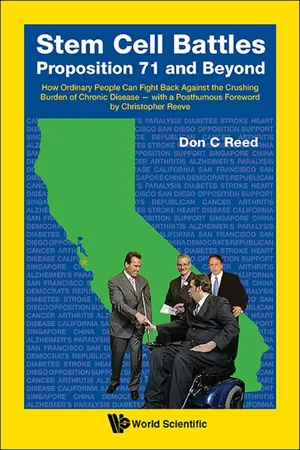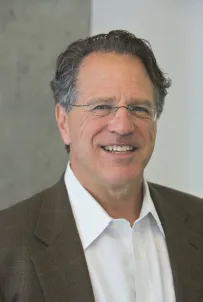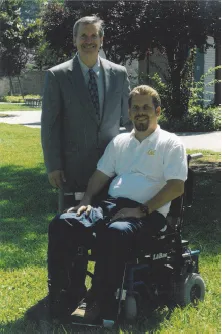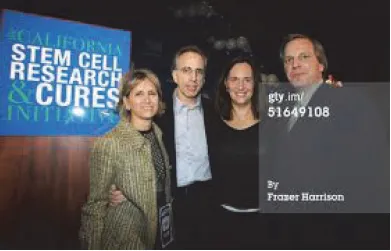
Stem Cell Battles: Proposition 71 and Beyond
How Ordinary People Can Fight Back against the Crushing Burden of Chronic Disease — with a Posthumous Foreword by Christopher Reeve
- 436 pages
- English
- ePUB (mobile friendly)
- Available on iOS & Android
Stem Cell Battles: Proposition 71 and Beyond
How Ordinary People Can Fight Back against the Crushing Burden of Chronic Disease — with a Posthumous Foreword by Christopher Reeve
About This Book
This is a one-of-a-kind book: combining easy-to-understand science, in-the-trenches political warfare, and inspirational stories. It aims to give hope to individuals and families who suffer from chronic disease or disability; to point out how ordinary people can make an extraordinary difference in the battle to ease suffering and save lives through supporting medical research; to share in “people talk” some of the amazing progress already achieved in the new field of stem cell research; to show how even such a magnificent success as the California stem cell program is under constant attack from ideological groups; to offer medical research as a force for international cooperation; to suggest how cure research lessens the need for the mountainous costs of endless care.
Unparalleled background: the author has been involved in virtually every important stem cell battle (state, national, and international) since embryonic stem cell research began. The author works closely with Robert N. Klein, sponsor of the California stem cell program, the largest source of such stem cell research funding in the world. In addition, the author is an award-winning teacher as well as writer, and seeks to entertain as well as educate. His book is not only substantive, but also fun.
The book would be a treasured gift: for anyone suffering an “incurable” illness or who is a caregiver for a loved one; for a college student considering a rewarding career in biomedicine; for scientists who want to protect and enhance their research funding; and for anyone who wants to see government respond to the needs of its citizenry. Chronic disease and disability are a prison: cure is the triumphant escape — wheelchairs should be for temporary occupancy only.
This is a one-of-a-kind book: combining easy-to-understand science, in-the-trenches political warfare, and inspirational stories. It aims to give hope to individuals and families who suffer from chronic disease or disability; to point out how ordinary people can make an extraordinary difference in the battle to ease suffering and save lives through supporting medical research; to share in “people talk” some of the amazing progress already achieved in the new field of stem cell research; to show how even such a magnificent success as the California stem cell program is under constant attack from ideological groups; to offer medical research as a force for international cooperation; to suggest how cure research lessens the need for the mountainous costs of endless care.
Unparalleled background: the author has been involved in virtually every important stem cell battle (state, national, and international) since embryonic stem cell research began. The author works closely with Robert N. Klein, sponsor of the California stem cell program, the largest source of such stem cell research funding in the world. In addition, the author is an award-winning teacher as well as writer, and seeks to entertain as well as educate. His book is not only substantive, but also fun.
The book would be a treasured gift: for anyone suffering an “incurable” illness or who is a caregiver for a loved one; for a college student considering a rewarding career in biomedicine; for scientists who want to protect and enhance their research funding; and for anyone who wants to see government respond to the needs of its citizenry. Chronic disease and disability are a prison: cure is the triumphant escape — wheelchairs should be for temporary occupancy only.
Frequently asked questions
Information




Table of contents
- Cover
- Half title
- Title
- Copyright
- Contents
- Foreword by Christopher Reeve
- Acknowledgements
- Chapter 1 The World’s Deadliest Killers
- Chapter 2 The Naked Face of Hate
- Chapter 3 To Clone, or Not to Clone?
- Chapter 4 Season of Storms
- Chapter 5 The Trial(S) of the California Stem Cell Program
- Chapter 6 When Changing the World, What Do You Do First?
- Chapter 7 Battles With a Friend
- Chapter 8 Time-Lapse Scriptography
- Chapter 9 Ideology, Science, or Bible-Quoting Vampires?
- Chapter 10 Joan of Arc, and the Republican Stem Cell Reversal?
- Chapter 11 Deadly Definitions
- Chapter 12 What are We Fighting for?
- Chapter 13 Suffer Little Children
- Chapter 14 Klein Must Resign!
- Chapter 15 Last Day in the Wolverine State
- Chapter 16 Getting up in the Morning and Going to — Washington?
- Chapter 17 The Boy Who Loved Stanford Too Much
- Chapter 18 Stem Cell Summit, Stem Cell World
- Chapter 19 How Not to Have Sex in a Personhood State
- Chapter 20 Fighting the Killers: Leukemia and Cancer
- Chapter 21 The Thief of Memory
- Chapter 22 The Anti-Science Society
- Chapter 23 Stem Cell Thanksgiving
- Chapter 24 Swimming from Alcatraz
- Chapter 25 Bridge to a New Life
- Chapter 26 Skidding on Ice
- Chapter 27 Helen Keller and Stem Cell Research
- Chapter 28 How to Mend a Broken Heart
- Chapter 29 Why We Can’t Afford Not to Cure Paralysis
- Chapter 30 The War We Must Not Lose
- Chapter 31 In Which I Get Cancer
- Chapter 32 Sickle-Cell Anemia and the Politics of Pain Stem Cell Program
- Chapter 33 Mowgli and the Matrix: A Year in the Life of the California
- Chapter 34 To Whom Goes the Kingdom?
- Chapter 35 The Liver List
- Chapter 36 The Will of Connecticut
- Chapter 37 Champions Find a Way
- Chapter 38 Disenfranchise the Disabled?
- Chapter 39 Adventures in Intellectual Property
- Chapter 40 Spartacus Fights Back Against Stroke
- Chapter 41 Diabetes Going Down?
- Chapter 42 Jamie Thomson, or, How Do You Follow an Act of Genius?
- Chapter 43 Sherley V. Sebelius
- Chapter 44 The Woman Who Would Not be Silenced
- Chapter 45 The Gorilla Gynecologist, or, the Pera-Chen Anti-Urinary-Incontinence Method
- Chapter 46 Turning Over Rocks: The Battle for Paralysis Cure
- Chapter 47 In Memory Still Green: The Passing of Three Giants
- Chapter 48 Invitation to Mexico
- Chapter 49 Of Presidents, and the Valley of Death
- Chapter 50 Little Hoover and the Institute of Medicine
- Chapter 51 Studying the Moon, Looking Through a Straw
- Chapter 52 The Great Nebraska Compromise
- Chapter 53 Stem Cell Tourism
- Chapter 54 The Man Who Could Fly Without a Plane
- Chapter 55 Thief of Lives
- Chapter 56 Singapore, Biopolis, and the Power of the Small
- Chapter 57 Singapore Scientists
- Chapter 58 Fighters Against Parkinson’s
- Chapter 59 International Friends
- Chapter 60 A Texas Miracle, or Thirty-Two
- Chapter 61 The Stem Cell Musketeers of Brazil
- Chapter 62 Adventures in China
- Chapter 63 Professor Forever and the Giant Squid
- Chapter 64 A Double Baker’s Dozen of Disease Team Grants?
- Chapter 65 The Greatest Speech You Never Heard
- Chapter 66 A Stem Cell Mystery: The Resignation of Mahendra Rao
- Chapter 67 Arthritis and the Fifty States
- Chapter 68 Would You Drink from a Fountain of Youth?
- Chapter 69 When Things Go Right
- Chapter 70 Where Did the Money Go? (and a New Year’s Delight at the End…)
- Chapter 71 The End?
- Appendix 1 Interview with Lim Chuan Poh, Chairman of A*Star and Biopolis
- Appendix 2 Interview with Hans Keirstead
- Appendix 3 Interview with Bob Klein
- Name Index
- Subject Index